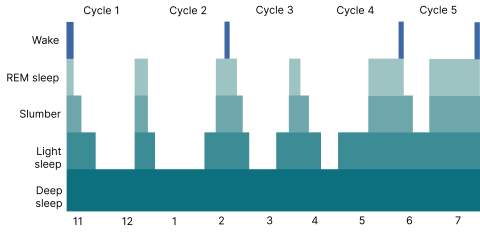Self-help program
What is sleep?
Sleep has several important functions for brain wellbeing:
- It repairs and builds the body and keeps the brain functioning.
- Sleep plays a housekeeping role in the brain, clearing out unneeded neural connections and strengthening necessary ones.
- Sleep also cleanses the brain of toxins that accumulate during waking hours.
Stages of sleep
Sleep is not homogeneous through the night but made up of stages. There are four stages of sleep, categorized according to the depth of sleep and what happens in the body during each stage.
Sleep can be either rapid-eye-movement (REM) sleep, also known as active sleep, or non-rapid-eye-movement (NREM) sleep, also known as quiet sleep. NREM sleep is further divided into three stages: N1 for the transition between wakefulness and sleep, N2 for light sleep and N3 for deep sleep.
Nocturnal awakenings
The amount of light sleep increases as the night progresses. Waking briefly in the night is part of normal sleep behavior.
A normal sleeper typically wakes up two or three times during the night and falls back asleep within approximately 10 minutes. Nocturnal awakenings tend to increase with age, and there is no need to worry about them.
Sleep cycles during a typical night:

Remember
Approximately half of all sleep is light sleep. Deep sleep accounts for between 15% and 20% of a full night’s sleep and REM sleep for 20%. The vast majority of dreams occur during REM sleep.
